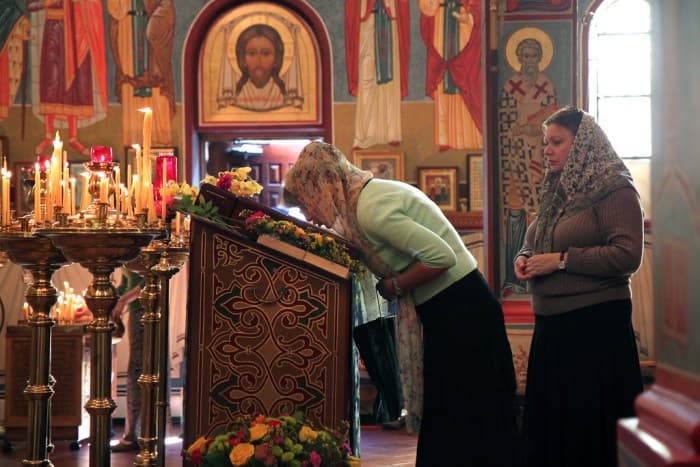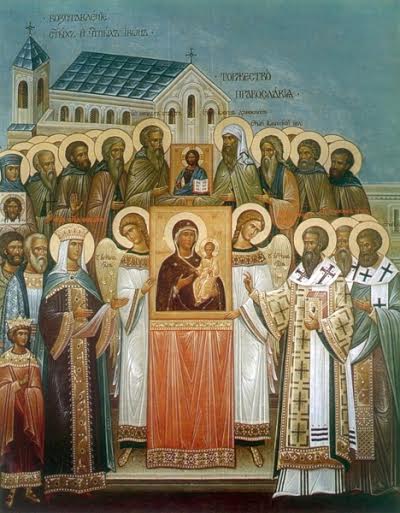On the first Sunday of Great Lent, we celebrate the Triumph of Orthodoxy over iconoclasm, the destruction of religious icons in the Church. During the services this weekend, we commemorate the restoration of icons for use in our services and in the private devotional lives of Orthodox Christians. In this post, we take a deeper look into iconoclasm and the importance of its defeat in the history of the Orthodox Faith.
5 minutes
The iconoclastic controversy
First iconoclasm, 730-787 A.D.
The Church’s struggles against iconoclasm began during the reign of Emperor Leo III the Isaurian, who banned the use of icons and commanded their destruction in 730 A.D. Excessive religious respect for and the ascribed miracles of icons appeared to border along the line of worship and idolatry. This instigated iconoclast extremists to push for the destruction of icons and their removal from the liturgical and devotional life of the Church. The Iconophiles, on the other-hand, believed icons preserved the doctrinal teachings of the Church; they considered icons as man’s dynamic way of expressing the divine through art and beauty.
Many Christian residents outside the Byzantine Empire refused to accept the emperor’s theological arguments against icons, St. John of Damascus among them. In his writings, St. John of Damascus clarified the distinction between worship and veneration, teaching that we worship God alone and simply venerate the icon as an image of the Prototype. In his defense of icons he wrote, “I do not worship creation over the creator.”

The first iconoclasm ended after Empress Irene came into power upon the death of her husband, Leo IV (Leo III’s grandson). As a venerator of icons, the Empress called the Seventh Ecumenical Council in A.D. 787. This ecumenical council affirmed the veneration of icons, at the same time explicitly forbidding worshiping them. The council insisted that because God the Son (Jesus Christ) became incarnate, we can now use physical matter to depict Christ and the Saints. Icon veneration lasted for a little under 30 years before coming under attack a second time.
Second iconoclasm: 813-843 A.D.
Emperor Leo V instituted a second period of iconoclasm in 813 A.D., which seems less gruesome with fewer martyrdoms and less public destruction of icons. Leo successor, Michael II, was succeeded by his son, Theophilus, whose death left his wife, the Empress Theodora, regent for his minor heir, Michael III. Like Irene 50 years before her, Theodora proclaimed the restoration of icons in 843 A.D. And since that time, we have celebrated the first Sunday of Lent as the feast of the “Triumph of Orthodoxy.”
Icons as an integral part of Orthodox spiritual life
Icons are an integral part of Orthodox faith and devotion, not just optional devotional extras. They show forth in a concrete, physical way the basic Christian belief in the Incarnation of the Word of God, the Second Person of the Trinity, in Jesus Christ. Icons have a distinctly sacramental character, because they make present the person or event depicted on them. This is why we see icons all over the interior of Orthodox churches and in Orthodox homes.
The declaration put forth by the Seventh Ecumenical Council illustrates the necessity of icons, and the distinction between veneration and worship of them, beautifully:
We define that the holy icons, whether in color, mosaic, or some other material, should be exhibited in the holy churches of God […] and in houses and along the roads, namely the icons of our Lord God and Savior Jesus Christ, that of our Lady the Theotokos, those of the venerable angels and those of all saintly people.
Whenever these representations are contemplated, they will cause those who look at them to commemorate and love their prototype. We define also that they should be kissed and that they are an object of veneration and honor (timitiki proskynisis), but not of real worship (latreia), which is reserved for Him Who is the subject of our faith and is proper for the divine nature. The veneration accorded to an icon is in effect transmitted to the prototype; he who venerates the icon, venerated in it the reality for which it stands.
Seventh Ecumenical Council
Read More: Why The Orthodox Kiss Icons
Icon of the Feast
In the icon for this feast, we see the triumphant celebration of the restoration of icons. Specifically, it illustrates the procession that took place on the first ever Sunday of Orthodoxy, March 11, 843 A.D. This procession went from the Church of the Theotokos in Blachernai to Hagia Sophia (about a 3.5 mile walk).

In the center of the icon is an icon called the Virgin Hodegetria, “She who shows the way to God”. Two angels carry the icon. To the left of the icon stands Empress Theodora and her son Michael III. Then to the right of the icon stand Patriarchs Methodios and Tarasios. Behind them stand numerous saints who struggled against the Iconoclastic heresy throughout history.
Commemoration of Moses, Aaron, Samuel, and the Prophets
Before the Triumph of Orthodoxy, the first Sunday of Great Lent celebrated Moses, Aaron, Samuel, and the Prophets. We still see traces of this in the Epistle reading during the Liturgy (Hebrews 11:24-26, 32; 12:2).
Conclusion
When the Church was still relatively small — in an anti-Christian society that persecuted followers of The Way — St. John the Evangelist, the beloved disciple of Christ, wrote: “And this is the victory, our faith, this is the victory”. There was no victory at that time. And yet he knew that in his Faith he had true victory in Christ. In His promise that the gates of hell will never prevail against the Church, that if we have faith, all things are possible. We have everything we need if we have our Faith, and therefore the victory is ours. And that victory of Christ in us will be the victory of His Church.
We sing on this day: “This is the Apostolic faith, this is the Orthodox faith, this is the faith of the Fathers, this is the faith that is the foundation of the world”. Dear brothers and sisters, this is our faith. We are the happy few that can say these things of our Faith. Having this treasure, let us preserve, keep, and use it well. Let this treasure become the victory of Christ in us and in His Church. Amen.
Keep Reading: Does The Second Commandment Forbid Icons?
